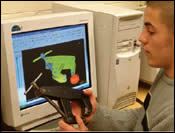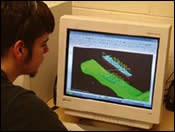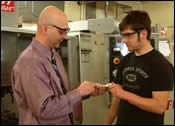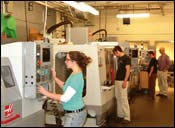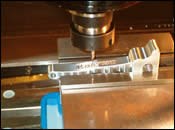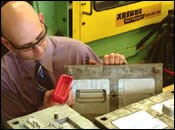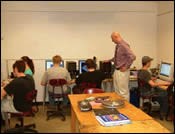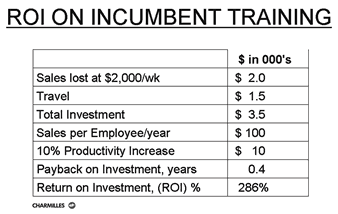Molding New Moldmakers
One school—with industry’s help—is a model for our future moldmakers’ education.
Share
Dropping down from the upper altitudes of the Taconic Range in the northwest corner of Massachusetts, the town of North Adams presents itself as a bustling, picture-postcard New England village. It is replete with a town square and boasts of ivy-covered college walls, a blend of boutique shops and mega-stores, stately homes and, yes, a generous sprinkling of flourishing metalworking companies. Firmly tied to New England’s heritage of the Yankee Toolmaker, North Adams is also home to Charles H. McCann Technical School, where talented students are being molded into a new generation of moldmakers.
Machine Tech Suite
Stepping into the Machine Tech suite at McCann is not unlike entering a busy machine shop in Anytown, USA—all the sights, sounds, and scents of metal being cut, ground, drilled, bored, chamfered, tapped and reamed—only here, the machine operators are students and the supervisors are teachers.
Production Layout
In the main production area, arranged according to operations performed are 14 manual lathes, 10 vertical milling machines, three surface grinders, a horizontal mill, and vertical and horizontal band saws. Just past these manual machines, in a linear step-up in technology, are five CNC milling machines, two CNC vertical machining centers and two CNC lathes. A second room houses an Agie EDM machine, an Arburg plastic injection molding machine and a setup area. A third room—a little bit away from the machining noises—is the Mastercam lab with 17 computer workstations.
Curriculum
According to Tom Matuszak, one of the school’s Machine Technology instructors, the moldmaking industry in Massachusetts has been on an upswing for the past few years, with a corresponding increase in the demand for skilled employees. “The average age of today’s moldmaker is over 50,” he says, “and companies are looking to schools like ours to provide them with bright, capable people. Our students are bright to begin with and as for capability, we lead them through a comprehensive four-year program that is accredited by the National Institute of Metalworking Skills (NIMS).”
Basic Machining Knowledge
The freshman class begins with basic machining knowledge, including layout, drill press work, benchwork and precision measurement. The curriculum is based on a tree-shaped format, comprised of projects conforming to the NIMS standards. Most of the metalworking projects must be completed to tolerances as close as .001”. The tolerances are checked and a quality control sheet is completed to determine if the student passed or failed. If the student fails on the first attempt, the project is repeated until the results are satisfactory. The instructors sign off on each project that is successfully completed and submit a performance affidavit to the school’s advisory board. The board’s members recheck the project results according to the established standards and forward the results to NIMS. The student is then contacted by NIMS and given a code to use at their online testing site in order to take an online theory-related test based on the skills evidenced by that particular project.
The site is provided by Tooling University. Students passing both the physical project standards and theory-related test are awarded a certificate attesting to their knowledge of the skills required to complete that project. A student may graduate at the end of the four-year curriculum not only with a diploma, but also with NIMS proficiency certificates that are recognized by industry throughout the U.S.
As the students advance up the curriculum tree, the branches represent technologies of increasing difficulty and complexity. Each project begins with a succession of algebra and geometry tasks—such as angle computation to provide an understanding of the basics before stepping up to the machine tool. At certain points, a student can branch off to concentrate either on CNC machining or on automated manufacturing with immersion in CAD/CAD, concentrating on the Mastercam educational curriculum. Once they have decided on their particular branch of study, they must continue on that path through the upper grades to graduation.
CNC Programming
In the sophomore year, students are introduced to CNC programming, specifically Mastercam X CAD/CAM software. “Our students have taken very quickly to the programming features of the new Mastercam X software,” says Matuszak. “We find that they are much more organized with Mastercam X than with previous generations of software. Whereas before they had problems managing various levels of project drawings, they now seem to understand and navigate the work much more easily.” Sophomores will concentrate on learning toolpaths and understanding the basics of CNC machine tool operations and programming.
Full Design and Production
“The junior year is a full blown Mastercam class,” says Matuszak. “We use the Mastercam curriculum and they go through the workbooks step by step. In the first quarter of the year, they are required to machine cavities and cores for molds. They go over the basics of Mastercam, including lines, arcs, solids, how to draw and switch different levels, and how to program cutter paths, such as pocketing and contouring.”
In the second quarter, the juniors design a key chain for an actual project. They begin by designing the key chain as a 2-D model and then create a solid, importing the cavities and cores they drew in the first quarter and end up with a good understanding of 3-D cutter paths and modeling. In the third quarter, they are given a 2-D print of a fixture that is known in industry as a can’t twist clamp.
“This is a great project,” says Matuszak. “They have to build a 3-D model from the 2-D print at their workstation, using the Mastercam X software. All the components for the clamp are on different sheets of paper and have to be properly set up to constitute the finished project. Using the software, they have to translate, mirror, rotate, and become proficient in different levels between wire frame and solid geometry models. If any of the students find they are having difficulty with one of the steps, they can go to eMastercam.com and actually have a two-way, problem-solving dialogue. It’s quite a nice teaching tool for us.”
Mastercam’s new CAD engine treats each piece of geometry as live, permitting quick and easy modification, simplifying even very complex parts. It allows for easy 2-D and 3-D geometry creation with complete wireframe and surface modeling. A wide range of NURBS and parametric surfaces may be quickly created, while flexible surface filleting provides constant radius fillets and point-and-click variable radius fillets.
In the fourth quarter of the junior year, the students make the cutter paths from the 3-D model. Mastercam’s fully associative geometry and toolpaths allows the students to modify the geometry or machining parameters, and immediately get an accurate, updated toolpath. By storing a library of commonly used operations, students can, for example, spot drill, peck drill and tap a series of holes simply by importing one stored operation.
Meanwhile, these students are learning the basics of plastic injection molding, using the cavities and cores they have machined from the programs they created at the CAD/CAM workstations. “They are always amazed,” says Matuszak, “that they wind up holding in their hands the actual product of something they began designing at the beginning of the school year.
“Most of the seniors,” he says, “in addition to working on advanced projects, also are learning the fundamentals of plastics technology, including chemical compositions, venting, gasses, how deep a gate should be, and so on. Believe me, they know which end is up in moldmaking by the time they graduate from McCann Tech.”
Industry Participation
While most of the department’s equipment comes from the school’s budget and through grants, local industry has proven to be very generous in donating materials and supplies. “Data Flute CNC, for example,” says Matuszak, “is located in nearby Pittsfield. They manufacture carbide end mills and other rotary tooling. For quite some time, they have been donating boxes of tooling that may not be exactly up to spec for their customers, but are fine for our use with the students. We are now working with them in producing a demo video of their new tooling that was shown at IMTS, with some of our juniors and seniors using Mastercam X to design various cutters and toolpaths from Data Flute’s drawings.
“Our A/V department has some high-tech video equipment that will let us do some high-speed video taping,” he continues. “When the final tape is shown at normal speed, the audience will see the Data Flute milling cutters removing chips in very dramatic slow-motion. Our students are very excited about this. They know that what they did for this video was seen by hundreds, if not thousands, of industry professionals at the Chicago show.”
Real World of Moldmaking
The Machine Technology department currently has about 60 students. If past placement history continues, 90 percent will either enter college as engineering majors, or begin full-time work as machinists and programmers in the metalworking or, more specifically, moldmaking industries—where 14 of the juniors and seniors are currently in co-op programs.
“I’m very proud of our students,” says Matuszak. “They study hard and they work hard. They all have a deep-seated desire to succeed and we try to further that desire by combining ‘real world’ experience with a learning world practical curriculum. I believe the real world of moldmaking will receive long-term benefits from what we’re doing here at McCann Tech.”
Related Content
Tackling a Mold Designer Shortage
Survey findings reveal a shortage of skilled mold designers and engineers in the moldmaking community, calling for intervention through educational programs and exploration of training alternatives while seeking input from those who have addressed the issue successfully.
Read MoreMMT Chats: The Science of Moldmaking, Part 2
In Part 2 of this two-part MMT Chat, Christina and Don continue their conversation by exploring lean manufacturing and tips on how to attract, train and retain the future workforce.
Read MoreConfronting the Mold Design Talent Drought
Recently, I reposted on LinkedIn the results of an informal survey we conducted, which revealed a shortage of skilled mold designers. It quickly gained a lot of traction. Given the response, I thought I'd summarize the feedback and keep the conversation going.
Read MoreHands-on Workshop Teaches Mold Maintenance Process
Intensive workshop teaches the process of mold maintenance to help put an end to the firefighting culture of many toolrooms.
Read MoreRead Next
Forty to 200 Percent ROI on Training
Strategies for attacking the lack of ongoing training dilemma that directly impacts our shops.
Read More

